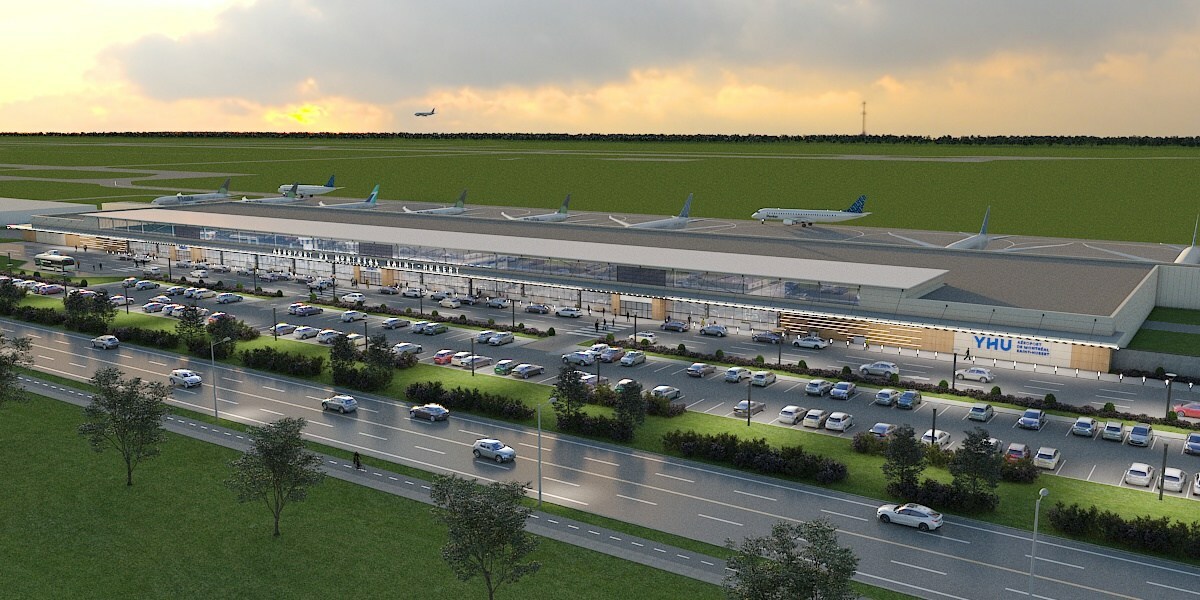The monopoly enjoyed by the Montreal-Trudeau airport (YUL) in Canada’s 2nd-largest metropolitan area is finally ending! The Montreal–Saint-Hubert airport (YHU), located in Longueuil, a suburb just across the river, has changed its name to “Montreal–Metropolitan airport.” In partnership with Porter, Canada’s fast-growing airline, they are currently building a brand-new terminal. That’s very exciting for all travelers — even those who are not going to fly to/from YHU.
As a traveler, I always welcome more competition.
The fact that competition is necessary and vital is why I agreed to be the president of the Trois-Rivières airport (YRQ) development committee in my hometown, where we are currently building a new terminal as well (albeit on a much smaller scale). There’s my disclosure as a “competitor”…
But as with all our Flytrippers content, I’m obviously writing as a traveler first and foremost, but also as an aviation expert and as a former management consultant and an MBA holder in the case of industry news like this.
Here are all the details about Montreal’s new secondary airport.
Overview of the new Montreal–Metropolitan airport
Here’s what we know:
- New option in the Montreal market
- Competition is good for travelers
- Almost every major city has a secondary airport
- YHU and PBG are the only existing alternatives close by
- Construction of a brand new terminal at YHU
- Partnership between YHU and Porter
- $200M investment
- Investissement de 200M$
- Construction 60-70% completed
- Opening in late 2025 (delayed twice)
- 25 routes planned (very ambitious)
- Domestic routes only (because of outdated rules)
- Porter would have routes at YUL and YHU (allegedly)
- Pascan’s existing routes will remain (small regional airline)
- Other airlines could follow (based on their photo mockup)
- Many benefits for travelers (locals and visitors to Montreal)
- Closer to downtown Montreal
- Express shuttle between the terminal and downtown
- More convenient and less chaotic than a big airport like YUL
- Much more enjoyable airport experience (except for airport lounges)
- Incentive for YUL and Air Canada to improve
- The airport was renamed (formerly Saint-Hubert airport)
- Montreal-Metropolitan airport
- MET is used as an abbreviation by the airport
- But the airport code remains YHU
I will now give you details for all of these elements.
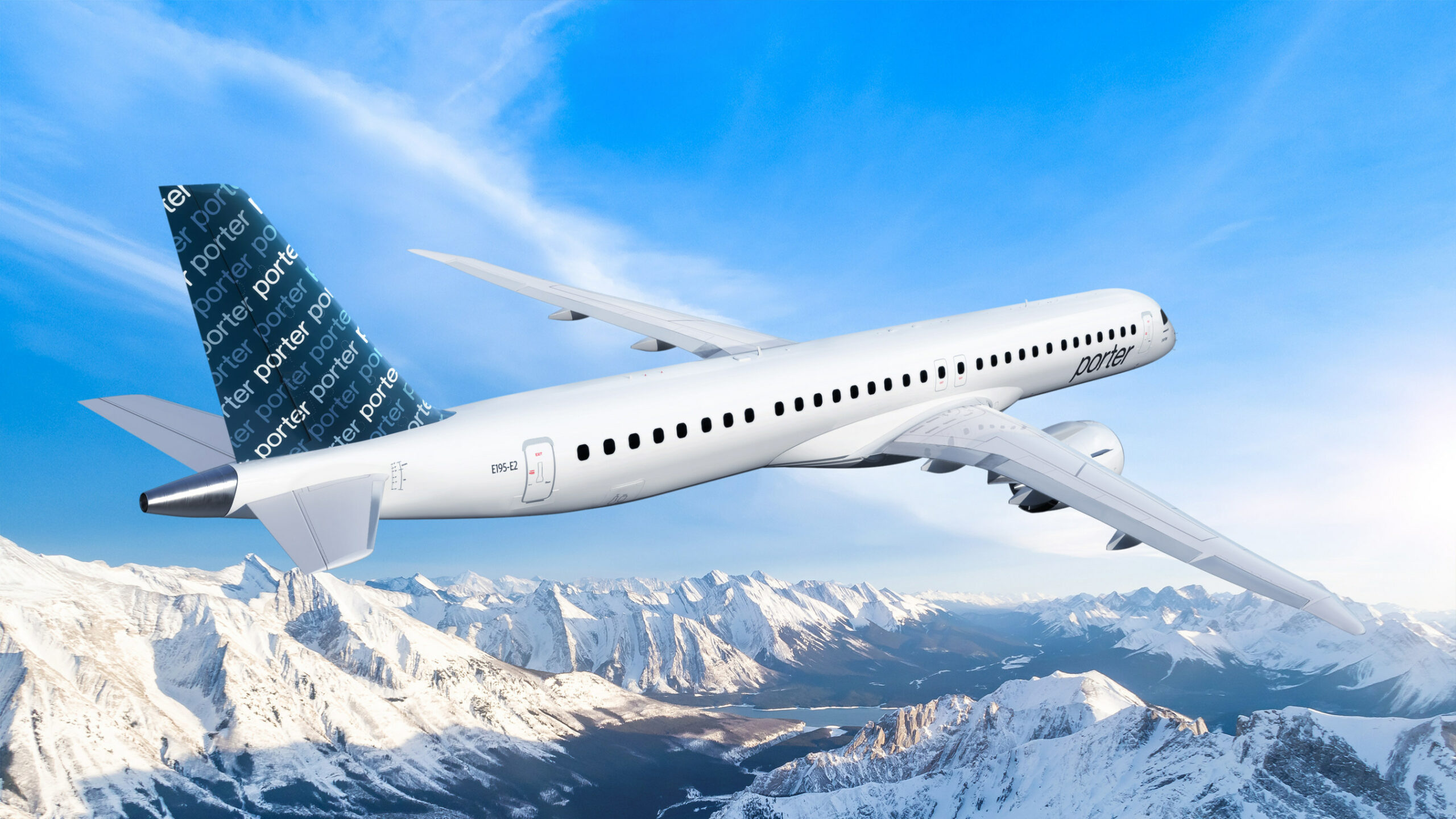
Details of the new Montreal–Metropolitan airport
Here is all the information about Montreal’s new secondary airport.
More airport competition in the Montreal market
First, it’s always positive to have more competition — and this fundamental economic principle doesn’t magically stop where governments artificially protect certain industries.
It’s certainly positive in the airport world!
I welcome this expansion at YHU because all over the world, it’s been proven that more choices and options for flights and airports are good for travelers (even if it’s necessarily one more competitor for eventual commercial service to Trois-Rivières, which I would love to have).
In Canada and the USA, 15 metropolitan areas have more people than the 4.2 million in the Montreal area. Exactly 14 of the 15 have a secondary airport with commercial air service. And the only one that doesn’t is Atlanta, which consequently has some of the highest flight prices in the USA, too.
It’s healthy for a world-class city not to have a monopoly! This expansion at Saint-Hubert airport will give Montreal a proper secondary airport.
Incentive for the other Montreal airport
The new Montreal–Metropolitan airport will benefit all travelers… not just those flying to/from the new airport.
More competition will force the other airport — and its main tenant Air Canada — to improve. That’s a basic staple of a market economy.
That’s definitely not a bad thing considering many of the issues related to aviation in Canada since the resumption of travel post-pandemic are not the fault of the airlines, but things that are the responsibility of the airports themselves!
With improved connections at YHU airport, YUL airport will have to enhance its experience, or more people will use YHU airport. So again, all travelers will win.
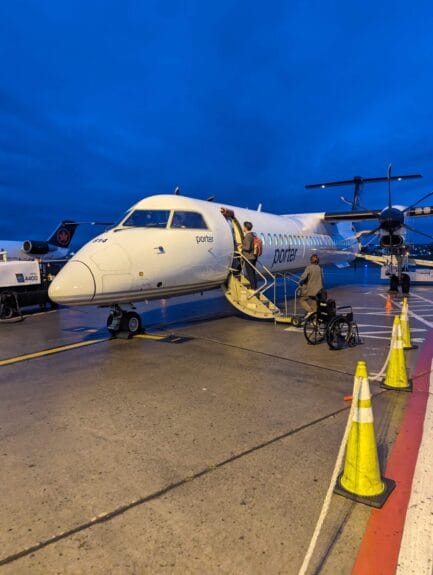
Existing secondary airports in the Montreal area
YHU airport already has commercial services, but they are extremely limited: only flights to airports within Québec, to Labrador City (on the Québec border), and to Saint John (New Brunswick). Pascan, a small regional airline, operates these flights. I’m not particularly interested in traveling within Québec personally, so I’ve never tried the YHU airport experience.
The only other competitor for YUL airport right now is Montréal’s American airport, Plattsburgh (PBG), just across the USA border.
Routes are limited, but if you are one of those who travel to Florida often from Québec, you know how quiet and pleasant the experience is at PBG (it’s a whole other world). That one I’ve tried over a dozen times, and I love it.
Airfares at the new Montreal–Metropolitan airport
At Montreal’s existing secondary airport in PBG, it can be incredibly more affordable in addition to more convenient — I’ve often paid US$40 roundtrip to Florida myself (including when our dollar was worth as much as our neighbor’s, which seems like an eternity ago with the current atrocious rate).
The addition of commercial air service at PBG has also lowered prices in Montreal for those same destinations.
But a secondary airport like YHU, launched by a premium airline — and not by an ultra low-cost carrier (ULCC) as secondary airports often are — will differentiate itself more on experience than on price.
But having any new secondary airport is better than not having a new secondary airport.
As for prices, it remains to be seen what level of airport fees (often called airport taxes) will be charged on every ticket that departs from YHU; it’s quite a significant component of the airplane ticket cost (as I illustrated in my analysis of Hong Kong’s giveaway of 500,000 “free” flights in 2023).
Those at YUL are among the highest in Canada! But YHU will need to recoup the huge investment required to build a brand-new terminal from scratch. They said the fee would be $30, but they had also said the opening would take place in 2024 and then in Summer 2025…
Porter offers very competitive prices on its current flights from YUL, so let’s hope it stays that way.
Opening date for the new Montreal–Metropolitan airport
The terminal was initially to be inaugurated by the end of 2024.
At the announcement in 2023, I had written this here:
That’s a pretty tight schedule for something of this magnitude, so it remains to be seen if they can do that. Let’s just say that in Québec, meeting deadlines is not a strong point, to put it mildly.
Update: what a surprise! My prediction was right.
It was first delayed until summer 2025, and now there’s an update in January 2025: the new terminal will open in late 2025. This is apparently due to delays in procuring electronic equipment.
Construction of the new terminal is now 60%-70% completed, so hopefully, this date is the right one! We should see if Porter starts selling flights this summer.
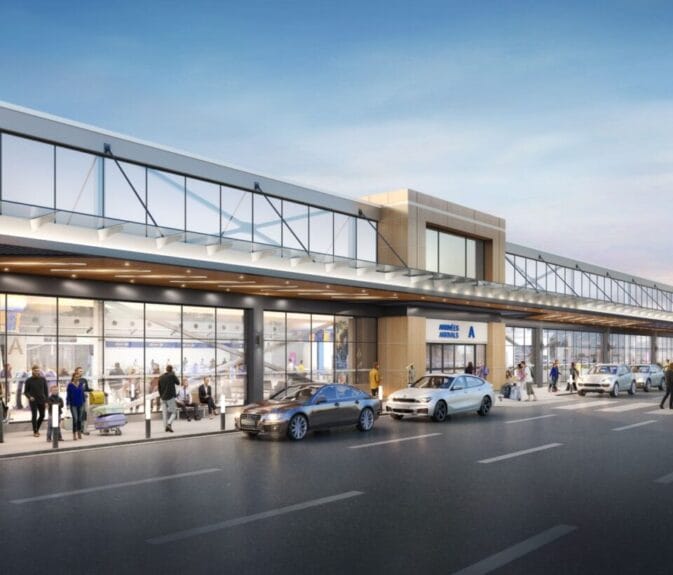
Location of the new Montreal–Metropolitan airport
Longueuil is just across the Saint-Lawrence River from downtown Montreal, but the airport is on that suburb’s edge.
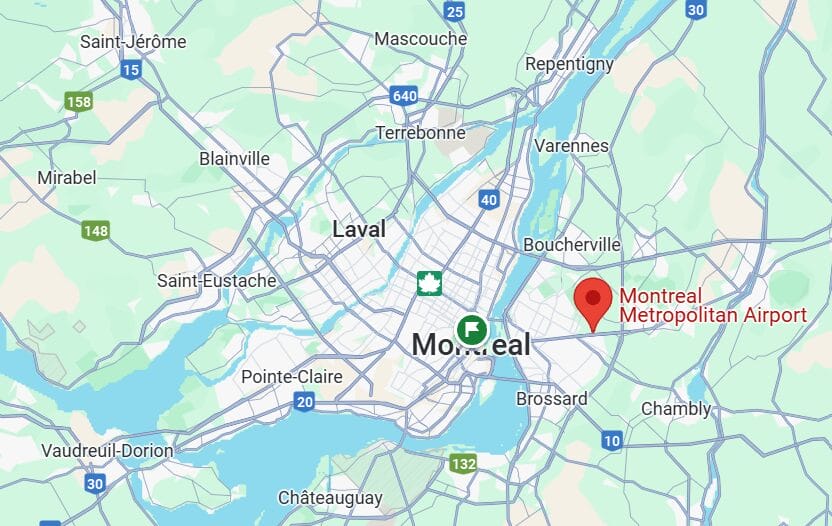
From downtown Montreal, YHU is a bit closer. Obviously, depending on where you are going in the Montreal area (or where you live if you’re local), the time difference to get to YHU airport compared to YUL will vary greatly.
The airport says there will be a shuttle, but they don’t specify that it’s free, so it’s safe to assume it won’t be (unlike the free YTZ shuttle, which is a much shorter ride). It remains to be seen if the price will be competitive with the $11 for the #747 bus to YUL operated by Montreal’s transit agency.
There will also be a new 130-room hotel at the airport — a Holiday Inn, a brand that is part of the IHG chain.
Experience at the new Montreal–Metropolitan airport
While the convenience in terms of the time to get there varies, what doesn’t vary is that it’s obviously going to be a much more pleasant and faster experience at the airport for (almost) everyone.
Essentially, Porter will replicate the business model they have been operating successfully in Toronto for years at the Toronto–Bishop (YTZ) secondary airport downtown. While YHU is not as close to downtown as YTZ is in Toronto, the benefits of a small secondary airport do apply!
If you’ve ever landed at YTZ, you know that in addition to a great view, it’s tiny, so everything is very efficient at the airport. Much better than Toronto–Pearson (YYZ). That’s a terribly low bar for sure, but still.
I love YTZ, and I hope it will be as enjoyable as YHU; I’m excited.
Terminal and lounges at the new Montreal–Metropolitan airport
The terminal is being built with a bright, modern design and “high-quality materials.” It will be “state-of-the-art” and “net zero.” It’s a total investment of 200 million dollars!
Porter is one of Canada’s most premium airlines. The terminal at YHU might also have a slightly more premium experience than a regular terminal, like what Porter offers to all its passengers at YTZ for free.
That means more comfortable seats, and that’s pretty much it now (I remember they offered free drinks and snacks for everyone in the terminal).
This is a far cry from the airport lounges that savvy travelers can access for free very easily (or rather get paid to access even), and there is no mention of any airport lounge in the announcement of this new terminal, which isn’t surprising for such a small airport. Maybe there’s space reserved for this for later, once there are enough passengers.
In the meantime, it’s clearly going to be better at YHU than outside of the airport lounges at YUL, that’s for sure. But those who have access to airport lounges in Montreal will have to consider that when choosing an airport.
(That said, access to lounges is quite restricted at YUL on the domestic side compared to the international side and compared to other major Canadian airports — only the premium-level Aeroplan cards give access to the domestic Air Canada Maple Leaf Lounge!)
Capacity of the new Montreal–Metropolitan airport
The terminal will have 9 gates as well as restaurants and stores. The surface area will be 225,000 square feet.
With a capacity of 4 million passengers per year, YHU will be able to accommodate a lot of flights.
To give you some context, that’s more than twice as much as the 2nd busiest airport in Québec, Québec City (YQB), which had only 1.7 million passengers in 2023. It’s also twice as much as the 2 million at Porter’s former main hub at YTZ.
Most importantly, though, YUL airport had 21 million passengers. About 7 million of them were on domestic flights. So, 4 million at YHU, for domestic flights only, is certainly ambitious.
The airport’s CEO mentioned that Porter and Pascan plan to use half the capacity and that the other half is available for other airlines.
It’s worth noting that flight operations are banned overnight, so all flights will take place between 6 AM and 11 PM.
Porter’s involvement in the new Montreal–Metropolitan airport
The project is a collaboration between Ontario-based airline Porter and the YHU airport. Porter is the key to this project, so it’s worth giving you some information about them.
Porter has grown significantly in the past few years, and this new terminal is part of that trend.
Porter essentially has 2 separate networks now:
- Turboprop aircraft from YTZ (which they’ve had for a long time)
- Jets from YYZ and many other airports (which is new)
That was a major change in strategy. It seems to be working, as they’ve launched many new routes, including many from Montreal (11 total).
Most importantly, they’re now a major competitor for Air Canada. This is a great example of the positive impact of competition in the travel industry!
Porter has offered free beer and wine on all their flights for years, so now Air Canada offers free beer and wine in economy for flights in Canada and the U.S. to match Porter (flights to the Caribbean are the only ones without this; because Porter doesn’t fly to the Caribbean. Porter was the only Canadian airline with free Wi-Fi (on the jets only), so now Air Canada will offer free Wi-Fi to one-up Porter (as it will be on the entire Air Canada fleet)!
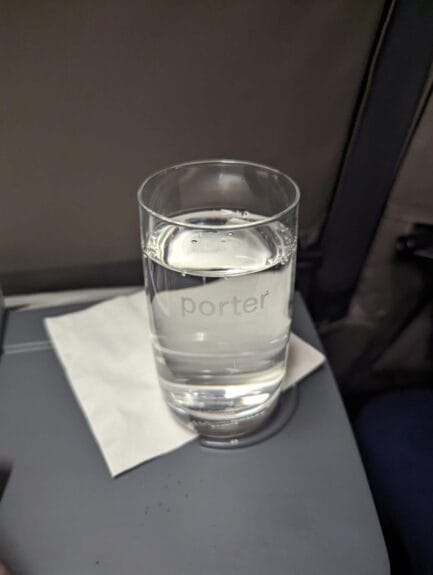
Before, Porter was very small. Turboprop aircraft have a smaller seating capacity but, most importantly, a shorter range. This limited their route network, as jets are not allowed at YTZ. The fact that YTZ is so close to downtown Toronto made Porter so popular.
Business travelers loved Porter for the airport’s location and the airline’s premium positioning. Leisure travelers already loved Porter’s often very competitive prices to USA destinations (with a stop at YTZ for those not from the GTA).
Now, with their brand-new Embraer jets (among the most quiet jets that exist), Porter has moved up to the big leagues (we had told you about their $1 sale to celebrate their new network). They’re now a true national airline, and all they have left to do is launch a co-brand credit card! 😉
I loved my experiences with Porter. While those were all on the turboprops, jets are usually much more enjoyable.
Routes from the new Montreal–Metropolitan airport
The airport promotes that there will be 25 routes when the terminal opens, which is ambitious too. For context, Pascan currently has 8 at YHU and Porter has 6 domestic routes at YUL.
That would mean 11 new ones… and that’s assuming all domestic ones are transferred from YUL to YHU (which is not the plan, apparently)!
The airport has published a map that shows 21 destinations.
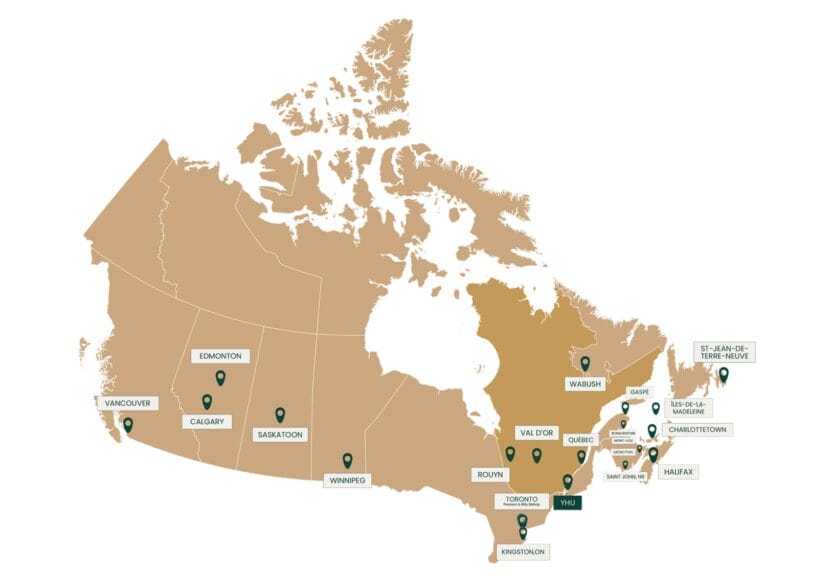
The actual routes from the Montreal–Metropolitan airport remain to be seen, but they will certainly be domestic routes only.
The Government of Canada protects YUL and gives them exclusive rights to international flights in the Montreal area, after the whole fiasco with the Montreal–Mirabel airport (YMX), one of the biggest white elephants and failures in world history.
Porter and Pascan plan to launch a codeshare partnership. It makes so much sense. Porter flights will carry passengers from all over Canada who will be able to connect to smaller destinations served by Pascan, and especially the opposite: from the smaller destinations to Canada.
As for Porter, the airline allegedly plans to continue its presence at YUL as well. They say it’s going to be complementary, like in Toronto. That remains to be seen; it’s terribly inefficient for such a small player to be in both airports (in Toronto, it makes more sense; they have a lot more flights, and the market is much bigger).
It would really be great if the outdated rule were abolished so Porter could regroup all its Montreal flights at YHU. It’s not that crazy to imagine that Air Canada and YUL would accept that: the current airport has major capacity constraints (from the curb to the runways) and demand is just going to keep increasing. If Air Canada wants to keep growing at YUL, who knows…
As for other airlines, while nothing at all has been announced, the terminal mockup by the Montreal–Metropolitan airport clearly shows planes with WestJet and Flair liveries. That could also make sense.
Finally, could Air Canada do as they did at YTZ and follow Porter into the secondary airport? That wouldn’t be surprising at all! I could see a single route to YYZ to at least be present on the most important city pair, just like they do at YTZ despite their massive hub at YYZ next door. That’s assuming Porter agrees to let them in, given their major role at the new airport.
Learning how to travel for less
Join over 100,000 savvy Canadian travelers who already receive Flytrippers’ free newsletter so we can help you travel for less (and keep you updated on all things travel)!
Summary
The new terminal to be built at Montreal–Metropolitan airport by Porter will create more airport competition in Canada’s 2nd-largest metropolitan area. This is great both for local travelers and for travelers from elsewhere in Canada who want to visit one of the country’s best destinations. It will give more choices and options, at least for domestic flights in Canada.
What do you want to know about the Montreal–Metropolitan airport? Tell us in the comments below.
See the flight deals we spot: Cheap flights
Discover free travel with rewards: Travel rewards
Explore awesome destinations: Travel inspiration
Learn pro tricks: Travel tips
Featured image: Future YHU airport terminal (photo credit: CNW Group/Porter Airlines Inc.)

